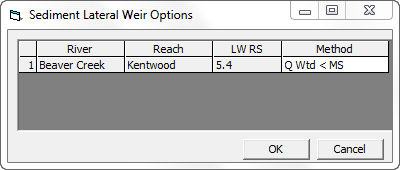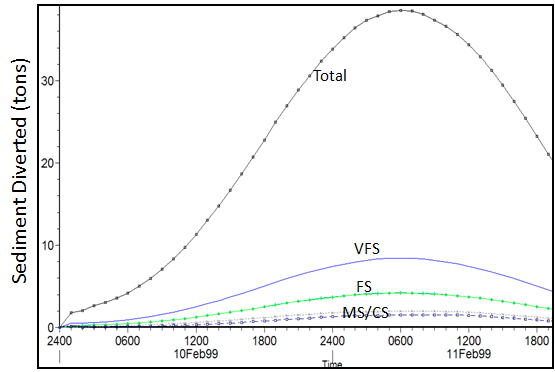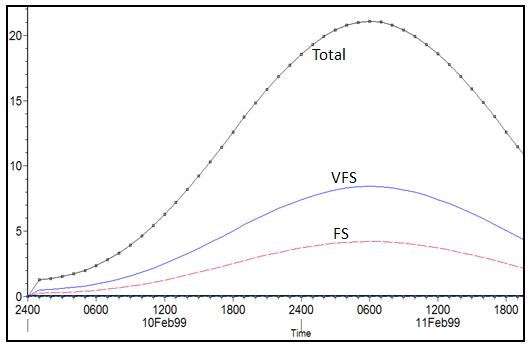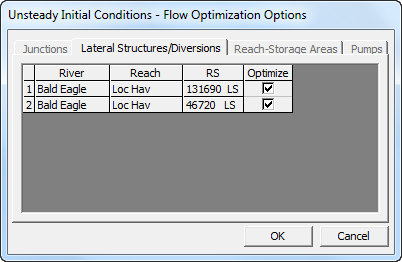Download PDF
Download page Lateral Structure.
Lateral Structure
HEC-RAS can simulate sediment transport with Lateral Structures in both quasi-unsteady and unsteady modes. Like flow splits, Lateral structures use the default assumption that sediment is diverted in proportion to the diverted flow (i.e. if 10% of flow leaves over a Lateral Structure, 10% of the transporting sediment will also divert, with the same gradation as the transporting sediment).
However, diverted sediment is usually substantially finer than sediment transporting in the main channel, especially if the diversion structure is perched higher than the bed load transport zone, or even the vertical center of mass of grain classes with low Rouse numbers. The Lateral Weir Options provide a "screen option" that prevents coarse grain classes from diverting.
Select the Lateral Weir Options to set Lateral Structure Diversion Thresholds. The editor will list all the Lateral Structures in the project and the Flow Weighted method will populate for each by default. HEC-RAS will compute the percentage of flow diverted, and then will divert that percentage of sediment, but will exclude the grain class selected and all coarser. For example, in the figure below, only the grain classes finer than medium sand will be diverted (producing the plot on the right). Because screened grain classes are excluded after the original sediment diversion computation, the diverted sediment mass will be less than proportional to flow (which is why the total sediment diverted drops as the filter is applied in the graphs below).

See the SedRuleLat.prj files in the example data sets for an example Lateral Structure application. This data set also illustrates how to leverage native Lateral Structure features for sediment studies, using operational rules to monitor sediment variables and operate gates in response to them.
HEC-RAS storage areas and 2D areas are are not connected to the 1D sediment transport model. If sediment from a 1D model is routed to a storage area with a Lateral Structure, it disappears from the model.


Modeling Note: Quasi-Unsteady Lateral Structures:
A note of caution on Lateral Structures and quasi-unsteady flow: flow over lateral structures is principally an unsteady phenomenon. As flow is diverted by a lateral weir, water levels drop, which leads to less flow over the weir. In unsteady flow, these feedbacks are accounted for implicitly. This is not the case with steady flow. An iterative approach can be employed in HEC-RAS to account for the feedbacks between flow diversion and the water level and converge on a solution. This option is not the default and has to be selected by going to the *OptionsFlow Optimization* menu in the Sediment Transport Analysis editor and selecting the Lateral Structures/Diversions tab.

Quasi-unsteady hydrodynamics are a series of steady flow analyses, so Lateral Structure flows are not accounted for implicitly. In order to account for feedbacks between diverted flows and water levels in quasi-unsteady flow optimize flow. However, this will increase run times dramatically, because the iteration required every time step by the optimization routines is computationally expensive. The alternatives are to move to an unsteady sediment transport model or compute a time series of flow diversion externally (e.g. with an unsteady flow run), add them as negative flows in the quasi-unsteady editor, and use the rating curve method (method 4 above) to compute sediment loads in the diversion.
Modeling Note: Lateral Structure Output
HEC-RAS does not provide sediment output by lateral structure. Instead, each cross section has a Lateral Diversion output variable, which sediment diverted from that cross-section's control volume by Lateral Structures or user specified diversions in the Rating Curve Boundary condition. Therefore, since lateral structures can span several cross sections, the total diverted sediment must be summed over all contributing cross sections.